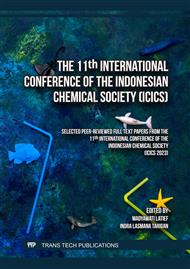[1]
D. Schaefer and W. M. Cheung, "Smart Packaging: Opportunities and Challenges," Procedia CIRP, vol. 72, p.1022–1027, 2018.
DOI: 10.1016/j.procir.2018.03.240
Google Scholar
[2]
Z. Wu et al., "Preparation and application of starch/polyvinyl alcohol/citric acid ternary blend antimicrobial functional food packaging films," Polymers (Basel)., vol. 9, no. 3, p.1–19, 2017.
DOI: 10.3390/polym9030102
Google Scholar
[3]
E. Syafri, A. Kasim, H. Abral, and A. Asben, "Effect of precipitated calcium carbonate on physical, mechanical and thermal properties of cassava starch bioplastic composites," Int. J. Adv. Sci. Eng. Inf. Technol., vol. 7, no. 5, p.1950–1956, 2017.
DOI: 10.18517/ijaseit.7.5.1292
Google Scholar
[4]
M. Shanmathy, M. Mohanta, and A. Thirugnanam, "Development of biodegradable bioplastic films from Taro starch reinforced with bentonite," Carbohydr. Polym. Technol. Appl., vol. 2, no. August, p.100173, 2021.
DOI: 10.1016/j.carpta.2021.100173
Google Scholar
[5]
N. Kasmuri and M.S.A. Zait, "Enhancement of bio-plastic using eggshells and chitosan on potato starch based," Int. J. Eng. Technol., vol. 7, no. 3, p.110–115, 2018.
DOI: 10.14419/ijet.v7i3.32.18408
Google Scholar
[6]
J. Mao, S. Li, J. Huang, K. Meng, G. Chen, and Y. Lai, "Recent Advances of Multifunctional Cellulose-Based Hydrogels," no. August 2019, p.37–64, 2019.
DOI: 10.1007/978-3-319-77830-3_5
Google Scholar
[7]
A. Jayakumar et al., "Starch-PVA composite films with zinc-oxide nanoparticles and phytochemicals as intelligent pH sensing wraps for food packaging application," Int. J. Biol. Macromol., vol. 136, no. September, p.395–403, 2019.
DOI: 10.1016/j.ijbiomac.2019.06.018
Google Scholar
[8]
P. Mustafa et al., "PVA/starch/propolis/anthocyanins rosemary extract composite films as active and intelligent food packaging materials," J. Food Saf., vol. 40, no. 1, 2020.
DOI: 10.1111/jfs.12725
Google Scholar
[9]
P. Rachtanapun et al., "Characterization of chitosan film incorporated with curcumin extract," Polymers (Basel)., vol. 13, no. 6, p.1–15, 2021.
DOI: 10.3390/polym13060963
Google Scholar
[10]
J. Wati and H. Hasby, "Analisis Aktivitas Antosianin dari Buah Senggani (Melastoma candidum L.), Kulit Kopi (Coffea arabica L.), dan Ubi Jalar Ungu (Ipomea batatas L.) Sebagai Indikator Asam Basa," KATALIS J. Penelit. Kim. dan Pendidik. Kim., vol. 3, no. 2, p.1–6, 2021.
DOI: 10.33059/katalis.v3i2.3107
Google Scholar
[11]
S. Qomariah, I. Syahbanu, and P. Ardiningsih, "Bioplastic Based on Taro Starch Modified Polyvinyl Alcohol and Eggshell (Starch-PVA-CT) with Degradability Study," EduChemia (Jurnal Kim. dan Pendidikan), vol. 7, no. 2, p.223, 2022.
DOI: 10.30870/educhemia.v7i2.14660
Google Scholar
[12]
P. Mustafa et al., "Improving functional properties of PVA/starch-based films as active and intelligent food packaging by incorporating propolis and anthocyanin," Polym. Polym. Compos., vol. 29, no. 9, p.1472–1484, 2021.
DOI: 10.1177/0967391120973503
Google Scholar
[13]
T. D. Huynh, "Starch recovery from turmeric powder (Curcuma longa) after ethanol curcumin extraction in comparison to the conventional method," J. Agric. Dev., vol. 20, no. 6, p.69–78, 2022.
DOI: 10.52997/jad.8.06.2021
Google Scholar
[14]
J. S. Jurenka, "Anti-inflammatory properties of curcumin, a major constituent of Curcuma longa: A review of preclinical and clinical research," Altern. Med. Rev., vol. 14, no. 2, p.141–153, 2009.
Google Scholar
[15]
A. Wulandari, T. C. Sunarti, F. Fahma, and T. Enomae, "The potential of bioactives as biosensors for detection of pH," IOP Conf. Ser. Earth Environ. Sci., vol. 460, no. 1, 2020.
DOI: 10.1088/1755-1315/460/1/012034
Google Scholar
[16]
U.J. Eke-Okoro, R.B. Raffa, J.V. Pergolizzi Jr, F. Breve, and R. Taylor Jr, "Curcumin in turmeric: Basic and clinical evidence for a potential role in analgesia." J Clin Pharm Ther., p.460–466, 2018.
DOI: 10.1111/jcpt.12703
Google Scholar
[17]
W.-H. Lee, C.-Y. Loo, M. Bebawy, F. Luk, R. Mason, and R. Rohanizadeh, "Curcumin and its Derivatives: Their Application in Neuropharmacology and Neuroscience in the 21st Century," Curr. Neuropharmacol., vol. 11, no. 4, p.338–378, 2013.
DOI: 10.2174/1570159x11311040002
Google Scholar
[18]
S.A. Rege, M. Arya, and S.A. Momin, "Structure activity relationship of tautomers of curcumin: a review," Ukr. Food J., vol. 8, no. 1, p.45–60, 2019.
DOI: 10.24263/2304-974x-2019-8-1-6
Google Scholar
[19]
A. N. Romainor, S. F. Chin, and S. Lihan, "Antimicrobial Starch-Based Film for Food Packaging Application." Starch ; Wiley-VCH GmbH, p.2100207 (1–9), 2022.
DOI: 10.1002/star.202100207
Google Scholar
[20]
J. Carvalho, J. Araujo, and F. Castro, "Alternative low-cost adsorbent for water and wastewater decontamination derived from eggshell waste: An overview," Waste and Biomass Valorization, vol. 2, no. 2, p.157–167, 2011.
DOI: 10.1007/s12649-010-9058-y
Google Scholar
[21]
G. Bin Cai et al., "1,3-Diamino-2-hydroxypropane-N,N,N',N'-tetraacetic acid stabilized amorphous calcium carbonate: Nucleation, transformation and crystal growth," CrystEngComm, vol. 12, no. 1, p.234–241, 2010.
DOI: 10.1039/b911426m
Google Scholar
[22]
D. Yanagisawa et al., "Relationship between the tautomeric structures of curcumin derivatives and their Aβ-binding activities in the context of therapies for Alzheimer's disease," Biomaterials, vol. 31, no. 14, p.4179–4185, 2010.
DOI: 10.1016/j.biomaterials.2010.01.142
Google Scholar
[23]
C. Medina-Jaramillo, O. Ochoa-Yepes, C. Bernal, and L. Famá, "Active and smart biodegradable packaging based on starch and natural extracts," Carbohydr. Polym., vol. 176, no. May, p.187–194, 2017.
DOI: 10.1016/j.carbpol.2017.08.079
Google Scholar


